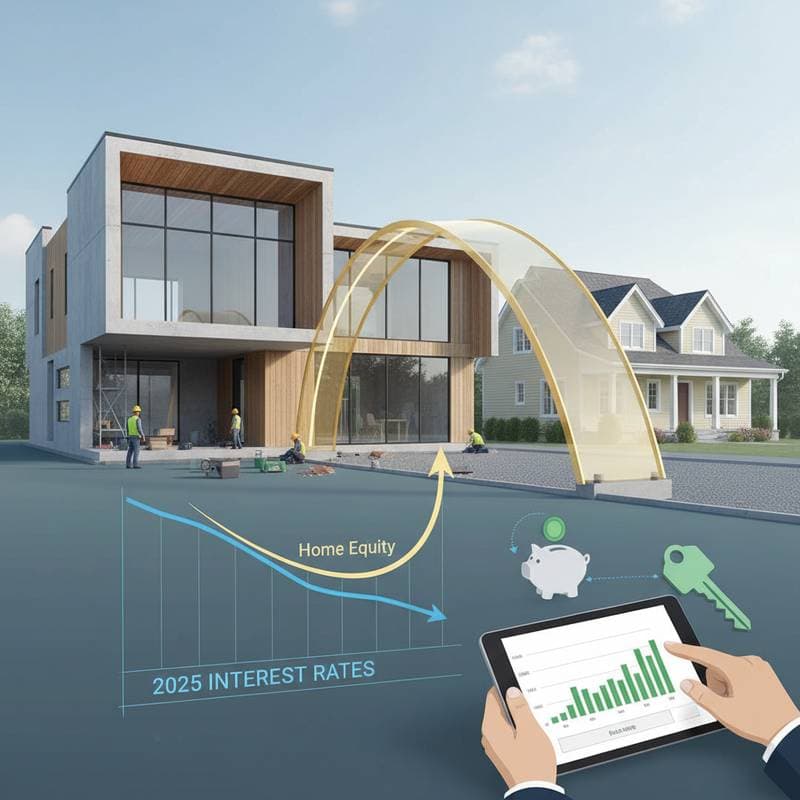Seize 2025 Rate Drops with Bridge Loans for Builds
A few weeks ago, I stood in my friend's half-finished dining room, coffee in hand, examining a wall of pale timber framing. She laughed and remarked, "I thought we would be done by now." The original plan seemed straightforward: sell the old home, begin the new build, and move in before the next rate adjustment. However, as often happens with construction projects, timing and financing did not align perfectly. That conversation led to a discussion about bridge loans and their role in smoothing such transitions, particularly as interest rates prepare to shift in 2025.
Coordinating the sale of one home while constructing another creates significant tension. Individuals seek to advance before rates increase further, yet they require proceeds from the current property to finance the next phase. Bridge loans address this challenge directly. They enable locking in construction progress at current rates while positioning for refinancing at lower rates later.
This article explores the mechanics of bridge loans, key considerations, and strategies to leverage current market conditions effectively.
Why Timing Matters for Builders and Homeowners
Interest rate fluctuations impact every aspect of home construction. Land prices rise, labor costs escalate, and material supplies tighten in response to higher rates. Builders frequently observe clients halting projects during peak rate periods, only to resume when conditions improve. This intermittent pattern disrupts schedules and inflates overall expenses.
A bridge loan maintains project momentum. Construction proceeds at prevailing prices, followed by refinancing into a more favorable long-term rate once rates decline. This approach delivers progress in the present and cost savings in the future.
Beyond finances, bridge loans provide psychological relief. Individuals avoid pressured sales of their current home or enduring prolonged construction disruptions. Moves can occur thoughtfully, without urgency.
What to Watch for Before Choosing a Bridge Loan
Bridge loans offer substantial flexibility, yet they require careful evaluation. Consider the following factors prior to proceeding:
-
Interest Rates and Fees: These loans typically feature rates slightly above standard mortgages due to their short-term nature and adaptability. If refinancing occurs promptly, the added cost often proves justifiable.
-
Repayment Timeline: Lenders generally require repayment within six to twelve months. Align build and sale schedules precisely with this period to prevent complications.
-
Market Conditions: Stable home prices in the local area support delaying a sale for optimal timing. A softening market, however, may necessitate listing sooner to mitigate risks of dual loan obligations.
-
Exit Strategy: Develop a defined repayment plan, such as selling the existing home, refinancing the new property, or securing alternative funds. A solid strategy ensures stability throughout the process.
Spotting the Right Time to Act
Interest rates follow predictable cycles. Builders detect early signs through rising lumber costs, increased demand for tradespeople, and renewed buyer interest. A downward trend in rates signals the ideal moment to act before competition intensifies.
For those contemplating a new build, initiate preparations now. Gather necessary documentation, consult lenders, and obtain pre-approval for a bridge loan. This readiness positions individuals to capitalize on rate drops without delay.
The Emotional Side of Building and Bridging
Home construction extends beyond financial transactions; it involves creating a space aligned with personal needs, daily habits, and a sense of belonging. Bridge loans safeguard this investment by allowing deliberate choices. They prevent hasty sales or design alterations driven by financial strain.
View bridge financing as an extension of personal space between life stages. Individuals can curate memories gradually, select interiors mindfully, and envision daily life in the new home. As rates shift favorably, this preparation culminates in a decision that balances practicality and emotion.
Practical Tips for a Smooth Transition
Implement these strategies to enhance the process:
-
Budget for Overlap: Allocate funds for several months of dual mortgage payments or bridge loan interest. Advance planning reduces financial pressure.
-
Check Your Local Market: Rapid home sales in the area shorten bridge loan duration. Slower markets benefit from the extended financial buffer.
-
Prepare for Appraisals: Lenders mandate valuations for both properties. Maintain the current home to achieve a favorable appraisal outcome.
-
Stay Flexible: Construction timelines may adjust unexpectedly. Bridge loans provide adaptability rather than imposing strict constraints.
Living with Your Design and Your Decisions
As the new home takes shape, tangible progress reignites enthusiasm. The aroma of fresh timber, morning sounds of construction, and emerging design elements reward the effort invested. With the bridge loan facilitating timely refinancing at lower rates, settlement into the new space occurs with financial assurance and personal satisfaction.
